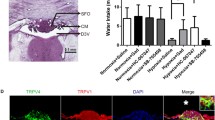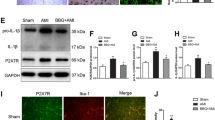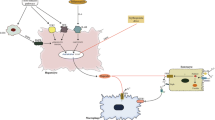Abstract
Reactive oxygen species (ROS) act as signaling molecules for maintaining homeostasis, particularly in the regulation of body-fluid balance in the paraventricular nucleus (PVN) of the hypothalamus. However, there has been little discussion regarding the source of ROS generation in this hypothalamic region. Because iron is the most abundant metal in the brain, we hypothesized that iron may act as a source of ROS, which regulate vasopressin (VP) expression. In the present study, we compared the amount of iron in the PVN to that in other forebrain regions of normal ICR mice, and examined the relationship among iron, ROS, and VP in the PVN of the iron-overloaded with iron dextran and iron-chelated mice with deferoxamine. The amount of iron in the PVN was significantly higher than in any of the forebrain regions we examined. The amount of iron in the PVN was significantly increased in iron-overloaded mice, although not in iron-chelated mice. These results suggest that the PVN exhibits high iron affinity. Both ROS production and VP expression in the PVN of iron-overloaded mice were significantly increased relative to levels observed in control mice. VP concentration in blood of iron-overloaded mice was also significantly higher than that of control mice. Interestingly, iron overload did not alter the expression of nitric oxide synthase, another modulator of VP expression. Taken together, our results suggest that high levels of iron in the PVN induce the production of ROS, which regulate VP expression, independent of nitric oxide signaling.











Similar content being viewed by others
References
Pereira RD, De Long NE, Wang RC, Yazdi FT, Holloway AC, Raha S (2015) Angiogenesis in the placenta: the role of reactive oxygen species signaling. BioMed Res Int 2015:814543
Barnham KJ, Masters CL, Bush AI (2004) Neurodegenerative diseases and oxidative stress. Nat Rev Drug Discov 3:205–214
Waris G, Ahsan H (2006) Reactive oxygen species: role in the development of cancer and various chronic conditions. J Carcinog 5:14
Poon HF, Calabrese V, Scapagnini G, Butterfield DA (2004) Free radicals: key to brain aging and heme oxygenase as a cellular response to oxidative stress. J Gerontol Ser A 59:478–493
Kalogeris T, Bao Y, Korthuis RJ (2014) Mitochondrial reactive oxygen species: a double edged sword in ischemia/reperfusion vs preconditioning. Redox Biol 2:702–714
Benani A, Troy S, Carmona MC, Fioramonti X, Lorsignol A, Leloup C, Casteilla L, Penicaud L (2007) Role for mitochondrial reactive oxygen species in brain lipid sensing: redox regulation of food intake. Diabetes 56:152–160
Leloup C, Magnan C, Benani A, Bonnet E, Alquier T, Offer G, Carriere A, Periquet A, Fernandez Y, Ktorza A, Casteilla L, Penicaud L (2006) Mitochondrial reactive oxygen species are required for hypothalamic glucose sensing. Diabetes 55:2084–2090
Abboud F, Floras J, Aylward P, Guo G, Gupta B, Schmid P (1990) Role of vasopressin in cardiovascular and blood pressure regulation. J Vasc Res 27:106–115
Wang G, Coleman CG, Chan J, Faraco G, Marques-Lopes J, Milner TA, Guruju MR, Anrather J, Davisson RL, Iadecola C, Pickel VM (2013) Angiotensin II slow-pressor hypertension enhances NMDA currents and NOX2-dependent superoxide production in hypothalamic paraventricular neurons. Am J Physiol Regul Integr Comp Physiol 304:R1096–R1106
Xia H, Suda S, Bindom S, Feng Y, Gurley SB, Seth D, Navar LG, Lazartigues E (2011) ACE2-mediated reduction of oxidative stress in the central nervous system is associated with improvement of autonomic function. PLoS ONE 6:e22682
Hidalgo C, Carrasco MA, Munoz P, Nunez MT (2007) A role for reactive oxygen/nitrogen species and iron on neuronal synaptic plasticity. Antioxid Redox Signal 9:245–255
Kishida KT, Klann E (2007) Sources and targets of reactive oxygen species in synaptic plasticity and memory. Antioxid Redox Signal 9:233–244
Yang Y, Bazhin AV, Werner J, Karakhanova S (2013) Reactive oxygen species in the immune system. Int Rev Immunol 32:249–270
Ji AR, Ku SY, Cho MS, Kim YY, Kim YJ, Oh SK, Kim SH, Moon SY, Choi YM (2010) Reactive oxygen species enhance differentiation of human embryonic stem cells into mesendodermal lineage. Exp Mol Med 42:175–186
Spooner R, Yilmaz O (2011) The role of reactive-oxygen-species in microbial persistence and inflammation. Int J Mol Sci 12:334–352
Gerlach M, Ben-Shachar D, Riederer P, Youdim MB (1994) Altered brain metabolism of iron as a cause of neurodegenerative diseases. J Neurochem 63:793–807
Kim JY, Lee EY, Sohn HJ, Kim DW, Cho SS, Seo JH (2014) Sequential accumulation of iron in glial cells during chicken cerebellar development. Acta Histochem 116:570–576
Jiang H, Luan Z, Wang J, Xie J (2006) Neuroprotective effects of iron chelator desferal on dopaminergic neurons in the substantia nigra of rats with iron-overload. Neurochem Int 49:605–609
Sofic E, Riederer P, Heinsen H, Beckmann H, Reynolds GP, Hebenstreit G, Youdim MB (1988) Increased iron (III) and total iron content in post mortem substantia nigra of parkinsonian brain. J Neural Transm 74:199–205
Mesquita SD, Ferreira AC, Sousa JC, Santos NC, Correia-Neves M, Sousa N, Palha JA, Marques F (2012) Modulation of iron metabolism in aging and in alzheimer’s disease: relevance of the choroid plexus. Front Cell Neurosci 6:25
St-Louis R, Parmentier C, Grange-Messent V, Mhaouty-Kodja S, Hardin-Pouzet H (2014) Reactive oxygen species are physiological mediators of the noradrenergic signaling pathway in the mouse supraoptic nucleus. Free Radic Biol Med 71:231–239
Rotondo F, Butz H, Syro LV, Yousef GM, Di Ieva A, Restrepo LM, Quintanar-Stephano A, Berczi I, Kovacs K (2016) Arginine vasopressin (AVP): a review of its historical perspectives, current research and multifunctional role in the hypothalamo-hypophysial system. Pituitary 19:345–355
St-Louis R, Parmentier C, Raison D, Grange-Messent V, Hardin-Pouzet H (2012) Reactive oxygen species are required for the hypothalamic osmoregulatory response. Endocrinology 153:1317–1329
Hill JM, Switzer RC 3rd (1984) The regional distribution and cellular localization of iron in the rat brain. Neuroscience 11:595–603
Li C, Odagiri S, Meguro R, Asano Y, Shoumura K (2009) Nonheme-iron deposition in the hypothalamo-neurohypophyseal system of the rat brain. Hirosaki Med J 60:63–76
Franklin KBJ, Paxinos G (1997) The mouse brain in stereotaxic coordinates. Academic Press, San Diego
Meguro R, Asano Y, Odagiri S, Li C, Iwatsuki H, Shoumura K (2007) Nonheme-iron histochemistry for light and electron microscopy: a historical, theoretical and technical review. Arch Histol Cytol 70:1–19
Seo JH, Haam YG, Park SW, Kim DW, Jeon GS, Lee C, Hwang DH, Kim YS, Cho SS (2001) Oligodendroglia in the avian retina: immunocytochemical demonstration in the adult bird. J Neurosci Res 65:173–183
Kim J-H, Jeong EM, Jeong Y-J, Lee WJ, Kang JS, Kim I-G, Hwang Y-i (2012) Transglutaminase 2 modulates antigen-specific antibody response by suppressing Blimp-1 and AID expression of B cells in mice. Immunol Lett 147:18–28
Kim MJ, Kim HK, Chung JH, Lim BO, Yamada K, Lim Y, Kang SA (2005) Increased expression of hypothalamic NADPH-diaphorase neurons in mice with iron supplement. Biosci Biotechnol Biochem 69:1978–1981
Negoescu A, Lorimier P, Labat-Moleur F, Drouet C, Robert C, Guillermet C, Brambilla C, Brambilla E (1996) In situ apoptotic cell labeling by the TUNEL method: improvement and evaluation on cell preparations. J Histochem Cytochem 44:959–968
Tokunaga A, Ono K, Ono T, Ogawa M (1992) Magnocellular neurosecretory neurons with ferritin-like immunoreactivity in the hypothalamic supraoptic and paraventricular nuclei of the rat. Brain Res 597:170–175
Hansen TM, Nielsen H, Bernth N, Moos T (1999) Expression of ferritin protein and subunit mRNAs in normal and iron deficient rat brain. Mol Brain Res 65:186–197
Reif DW (1992) Ferritin as a source of iron for oxidative damage. Free Radic Biol Med 12:417–427
Ray PD, Huang B-W, Tsuji Y (2012) Reactive oxygen species (ROS) homeostasis and redox regulation in cellular signaling. Cell Signal 24:981–990
Giorgi C, Agnoletto C, Baldini C, Bononi A, Bonora M, Marchi S, Missiroli S, Patergnani S, Poletti F, Rimessi A (2010) Redox control of protein kinase C: cell-and disease-specific aspects. Antioxidants redox signaling 13:1051–1085
Yoshida M (2008) Gene regulation system of vasopressin and corticotoropin-releasing hormone. Gene Regul Syst Bio 2:GRSB. S424
Storici P, De Biase D, Bossa F, Bruno S, Mozzarelli A, Peneff C, Silverman RB, Schirmer T (2004) Structures of gamma-aminobutyric acid (GABA) aminotransferase, a pyridoxal 5′-phosphate, and [2Fe-2S] cluster-containing enzyme, complexed with gamma-ethynyl-GABA and with the antiepilepsy drug vigabatrin. J Biol Chem 279:363–373
Vega C, Moreno-Carranza B, Zamorano M, Quintanar-Stephano A, Mendez I, Thebault S, Martinez de la Escalera G, Clapp C (2010) Prolactin promotes oxytocin and vasopressin release by activating neuronal nitric oxide synthase in the supraoptic and paraventricular nuclei. Am J Physiol Regul Integr Comp Physiol 299:R1701–R1708
Yamova L, Atochin D, Glazova M, Chernigovskaya E, Huang P (2007) Role of neuronal nitric oxide in the regulation of vasopressin expression and release in response to inhibition of catecholamine synthesis and dehydration. Neurosci Lett 426:160–165
Gillard ER, Coburn CG, de Leon A, Snissarenko EP, Bauce LG, Pittman QJ, Hou B, Curras-Collazo MC (2007) Vasopressin autoreceptors and nitric oxide-dependent glutamate release are required for somatodendritic vasopressin release from rat magnocellular neuroendocrine cells responding to osmotic stimuli. Endocrinology 148:479–489
Bharath S, Hsu M, Kaur D, Rajagopalan S, Andersen JK (2002) Glutathione, iron and parkinson’s disease. Biochem Pharmacol 64:1037–1048
Altamura S, Muckenthaler MU (2009) Iron toxicity in diseases of aging: alzheimer’s disease, parkinson’s disease and atherosclerosis. J Alzheimers Dis 16:879–895
Connor JR, Pavlick G, Karli D, Menzies SL, Palmer C (1995) A histochemical study of iron-positive cells in the developing rat brain. J Comp Neurol 355:111–123
Sturrock RR (1992) Stability of neuron number in the ageing mouse paraventricular nucleus. Ann Anat 174:337–340
Acknowledgements
This research was supported by the Basic Science Research Program through the National Research Foundation of Korea (NRF) funded by the Ministry of Education, Science and Technology (NRF-2013R1A1A2011095), and the intramural research grant of Chungbuk National University in 2015.
Author information
Authors and Affiliations
Corresponding author
Ethics declarations
Conflict of interest
None of the authors have any conflicts of interest to declare.
Additional information
Publisher’s Note
Springer Nature remains neutral with regard to jurisdictional claims in published maps and institutional affiliations.
Electronic supplementary material
Below is the link to the electronic supplementary material.
Rights and permissions
About this article
Cite this article
Hyeun, JA., Kim, J.Y., Kim, C.H. et al. Iron is Responsible for Production of Reactive Oxygen Species Regulating Vasopressin Expression in the Mouse Paraventricular Nucleus. Neurochem Res 44, 1201–1213 (2019). https://doi.org/10.1007/s11064-019-02764-x
Received:
Revised:
Accepted:
Published:
Issue Date:
DOI: https://doi.org/10.1007/s11064-019-02764-x




